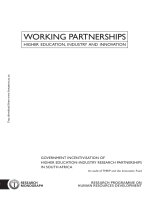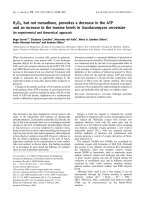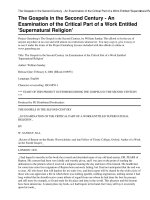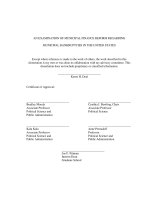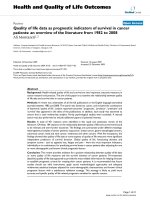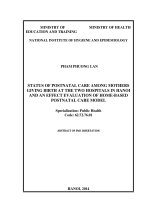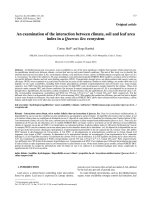Defining the pakistani nation in history education an examination of pakistan studies textbooks
Bạn đang xem bản rút gọn của tài liệu. Xem và tải ngay bản đầy đủ của tài liệu tại đây (580.44 KB, 130 trang )
DEFINING THE PAKISTANI NATION IN
HISTORY EDUCATION: AN EXAMINATION OF
PAKISTAN STUDIES TEXTBOOKS
WANG YAQIAN
(B.A., Peking University)
A THESIS SUBMITTED
FOR THE DEGREE OF MASTER OF ARTS
SOUTH ASIAN STUDIES PROGRAMME
NATIONAL UNIVERSITY OF SINGAPORE
2011
Acknowledgements
This thesis, marking the end of my Master’s study, has been shaped by all the
scholars who have taught and helped me so much, from my first undergraduate
modules to their latest comments on my thesis.
I especially want to express my sincere gratitude to my supervisor, Associate
Professor Yong Mun Cheong, Head of the South Asian Studies Programme, National
University of Singapore. Without his inspiration, patience, support, great efforts to
revise my thesis from structure to language, the thesis would not have been
accomplished.
I am also deeply grateful to Dr. Gyanesh Kudaisya and Prof. Tang Mengsheng,
for their sound advice and encouragement on the initial stage of my study. I would
like to thank Dr. Andrea M. Pinkney, who offered very detailed suggestions on my
writing. I wish to thank my supervisor, Prof. Tan Tai Yong, for helping me continue
my study when I went through a tough time.
My gratitude also goes to Prof. Ishtiaq Ahmed and my colleague Hussain Ahmed
Khan, who provided their kind assistance with collecting primary resources from
Pakistan when I was able to. I wish to thank in addition Dr. Rahul Mukherji, Dr.
Indivar Kamtekar, and all the other teachers who have supported my study.
During my study at NUS, I have been blessed with a number of inspiring and
friendly colleagues, Dr. Taberez Ahmed Neyazi, Dr. Priya Manish Jaradi, Mr. Irfan
Waheed Usmani, Dr. Sujoy Dutta, Ms. Hema Kiruppalini, Ms. Shin Sojin and Mr.
Ngawang Drakpa. Thank all of them for sharing the best time of my graduate study
I
with me and giving me constructive suggestions on my writing.
I also appreciate the administrative staff members who have been very helpful
and made my study at NUS very pleasant.
I thank all my friends and my fiancé Xia Jianzhong, who kindly supported me in
the successful completion of my thesis.
Lastly, my deepest gratitude goes to my entire family. I specially thank my
parents, Hao Yusu and Wang Sen for holding belief in me and encouraging me to
pursue degree abroad.
II
Table of Content
Summary....................................................................................................................................V
Introduction.............. .............. .............. .............. .............. .....................................................1
Main Arguments...................................................................................................................3
Past research.........................................................................................................................4
Methodologies......................................................................................................................8
Chapter outlines.................................................................................................................11
Primary resources and limitations of research...................................................................13
Chapter One: National Identity Construction and History Education.....................................16
Identity and education........................................................................................................16
Modern education and construction of national identity.................................................18
History as a unique subject in school education............................................................21
Conclusion........................................................................................................................24
Chapter Two: History Teaching and National Identity Building: Pakistan’
Case...................................................................................................................................25
The complex national identity of Pakistan....................................................................25
Pakistan Studies...............................................................................................................33
Perceiving the subject of Pakistan Studies and the textbooks..........................................39
Conclusion........................................................................................................................41
Chapter Three: Defining the Pakistani Nation........................................................................43
Who are the ancestors? ....................................................................................................44
Who are the heroes? ........................................................................................................56
III
The common cultures.......................................................................................................72
Conclusion.......................................................................................................................78
Chapter Four: Distinguishing the Pakistani Nation from Others...........................................81
Highlighting the difference..............................................................................................82
Emphasis on the conflicts................................................................................................83
Demonstration of the superiority.....................................................................................86
Conclusion.......................................................................................................................87
Chapter Five: Islam: the “Best Unifying Symbol” ...............................................................89
Exposure to the Islamic knowledge................................................................................90
Muslim, a separate nation...............................................................................................94
Islam and the state of Pakistan........................................................................................97
Conclusion: Islam— A Solution...................................................................................104
Conclusion..........................................................................................................................106
Bibliography.......................................................................................................................109
Appendix: Original Copy of the Questionnaires for Local Students and
Teachers..............................................................................................................................119
IV
Summary
The main issue addressed by this thesis is the creation of national identity through
history textbooks that are used for Pakistan’s middle schools. History textbooks have been
widely acknowledged as an important bastion for governments to build national images and
identity among students. As a country with serious identity crisis, Pakistan laid great
emphasis on transmitting the idea of the Pakistani nation through history teaching so that the
young generation would identify with the nation.
The teaching of history in Pakistan has experienced a series of changes along with
curricula reforms. Nowadays, history knowledge is mainly imparted in the textbooks of
Pakistan Studies rather than taught as an independent subject. The Pakistan Studies textbooks
thus became a very important source to investigate how the Pakistani nation was defined by
successive governments.
The idea of the Pakistani nation was defined and promoted in the Pakistan Studies
textbooks in a number of ways. The textbooks attempted to introduce some national symbols
shared by all the Pakistanis. Such symbols included common ancestors, heroes and culture. In
order to further consolidate the concept of the Pakistani nation, the Pakistan Studies
textbooks also tried to differentiate the Pakistani nation from other nations to students. By
reading the history sections from the Pakistan Studies textbooks, students would have an idea
of the Pakistani nation and other nations. The Pakistani nation consisted of the Muslims who
strove for the benefit of the Muslim community and enjoyed the rich cultural legacy left by
their great ancestors. In addition to many symbols delineating the image of the Pakistani
nation, Islam was made a special symbol in the textbooks to unify the vast majority of
V
Pakistanis.
This research provides a detailed analysis on how Pakistan Studies textbooks imparted
and promoted the idea of the Pakistani nation in history teaching. Although the construction
of national identity requires efforts of many aspects, the history teachings in middle school,
however, directly reflects the ideal image of the nation prescribed by the governments.
VI
Introduction
The event of the 9/11 attacks brought about worldwide concern over the link between
Islamic religious education and Islamic fundamentalism. Scholars and politicians around the
world were gravitated to investigate how religious education moulded the extremist and
terrorist mind-set in Muslim community. For a moment, researchers continuously brought
forth evidence to show the connection between madrasa1 education and the formation of
fundamentalist and extremist minds. Madrasa in Pakistan was one focal point of such
researches. Along with the increasing study on madrasa education in Pakistan, the teaching
materials of Pakistan’s public schools also attracted broad public attention for its biased and
ideology-driven content. Many domestic and foreign experts began to pay attention to the
problems in the textbooks prescribed by Pakistan’s government. The criticism of Pakistan’s
textbooks have also been the topics of a number of newspapers and news websites in the past
decade, including British Broadcasting Corporation, The Hindu, Times of India, Dawn and
Daily Times from Pakistan, etc.2 For instance, one article published on The Hindu website in
2004 reviewed the past scholarly works on criticising Pakistan’s history textbooks; it
described the distortion of history narratives in Pakistan’s history textbooks as “even more
tragic and traumatic” than India’s history textbooks.3 All the above-mentioned media have
reported the problems found from the textbooks of Pakistan, especially from the materials of
history teaching. The major problems involved the indoctrination of Islamic extremism,
hatred language towards the Hindus, glorification of Pakistan’s military rule, and distortion of
1
Madrasa, transliterated from Arabian. In Arabian, it refers to learning institutions regardless of religious or
secular. However, when this word is transliterated in English, it usually refers to middle level Islamic education
institution. It is also transliterated as “madrasah”, “madrassa” or “madrassah”, etc.
2
See Bibliography for a selection of news published in the mentioned newspapers and news websites.
3
Refer to B. G. Verghese, “Myth and Hates as History”, published on The Hindu website on Jun 23, 2004.
/>
1
history and so on.
The criticism revealed that Pakistan’s history teaching materials was full of biased
presentation of history. However, it is always difficult to tell what a good history textbook is.
The standard varies as the purpose of history teaching changes. If the purpose is to train
students’ critical thinking for history, a good history textbook may be the one which
familiarises students with academic methodologies of history study. If the purpose is set to
help students have an idea of what happened in the past, a good history textbook may be the
one which carries as more factual information as possible. If the purpose is set to identify
students with their nation and country through history learning, a good history textbook must
be the one which inspires the feeling of patriotism and strengthens the ties between fellow
countrymen, although the presentation of history may be subjective, biased and
ideology-driven.
In the modern world, textbooks fulfil a number of tasks. Besides “transmitting
knowledge, textbooks also seek to anchor the political and social norms of a society.
Textbooks convey a global understanding of history and of the rules of society as well as
norms of living with other people.”4 Regarding Pakistan’s case, the history textbooks are
designed to cater to the particular political and social needs of Pakistan’s society. The
textbooks, which largely deviate from the mainstream historiography, are a satisfactory
version of history in the eyes of Pakistan’s government. What is presented, omitted and
emphasised in the history textbooks reflects Pakistan’s official views on what kind of past
should be transmitted to the next generation. It has been pointed out by UNESCO Guidebook
4
Hanna Schissler, “Limitations and Priorities for International Social Studies Textbooks Research”, International
Journal of Social Education (4, 1989-1990), 81.
2
on Textbook Research and Textbook Revision that the aim of international textbook analysis
lies in promoting international understanding.5 In this sense, an analysis of Pakistan’s
controversial history textbooks, instead of telling right from wrong, serves a more important
purpose: understanding Pakistan from these textbooks.
1. Main Arguments
This thesis explores the construction of national identity through history teaching in
Pakistan. It focuses on the analysis of Pakistan’s history textbooks published in recent years.
History textbooks have been employed by governments of many modern nation states as an
important tool to build national identity among the young generation students. Pakistan’s
government also regards highly the role of history textbooks in identifying students with the
country. However, it remains a question to properly define Pakistan’s complex national
identity. In this situation, how Pakistan’s history textbooks transmit the complex definition of
national identity becomes the central question which guides the research of this thesis.
This thesis argues that the modern education system makes it possible for governments
to transmit uniform knowledge and information to students through history teaching. The
history textbooks carry the official perspective and transmit it to students so that students
could identify themselves with the nation defined in the textbooks. How is the Pakistan nation
defined in the textbooks? This study deals with this question from the approach of content
analysis. It argues that the promotion of national identity in the textbooks is embodied by
building icons and symbols of a nation. Therefore an analysis of the textbooks on the
presentation of these unifying symbols constitutes the major body of this thesis. This study
5
Falk Pingel, UNESCO Guidebook on Textbook Research and Textbook Revision, 2nd revised and updated ed.,
(Paris: Braunschweig, 2010), 8.
3
selects four major national symbols promoted in the textbooks to analyse: the ancestors,
heroes, cultures and Islam. It also analyses how the textbooks teach students to differentiate
the Pakistani nation from other nations. By analysing the presentation of the unifying
symbols and comparing the Pakistani nation with other nations in the textbooks, this study
depicts the image of the Pakistani nation which is promoted in history textbooks.
2. Past research
There have been a number of research studies on Pakistan’s history education, which
approached this topic from different angles. Generally speaking, the research studies can be
divided into the following three categories according to their approaches: education politics
in Pakistan; curricula analysis and critique; and history textbook analysis. Some studies deal
with this topic from only one approach; while others discuss the issues from multiple
approaches.
The publications on education politics in Pakistan refer to those which mainly discuss
the relations between education and power, e.g., how different political forces exert influence
on the formulation of education policies in Pakistan and how education programmes are
implemented. Some studies emphasise the education policies of a particular period. For
example, Rubina Saigol’s publication Becoming A Modern Nation: Educational Discourse in
the Early Years of Ayub Khan (1958-1964) presents the major visions and perspectives on
education in the early years of Ayub’s regime.6 Some other studies are not limited to the
discussion of one administration. There are also studies dealing with the research of school
education politics, explaining the role of teachers, students and other education staff in daily
6
Refer to Rubina Saigol, Becoming A Modern Nation: Educational Discourse in the Early Years of Ayub Khan
(1958-1964) (Islamabad: Council of Social Sciences, 2003).
4
educational activities. The article “Democracy and Education in Pakistan” written by
Muhammad Nazir deals with the existence and development of democracy in everyday
educational practices in schools.7 It reflects the change of power structures in education
setting. Such works are precious in understanding the changes of how Pakistan’s schools run
every day, but they are more inspiring for research of educational management other than
national identity building. Studies on education politics in Pakistan usually do not include
much analysis of the textbooks or particularly focus on history education; however, they
provide an understanding of all the related participants in education activities, such as
government, intellectuals, educators and students and so on.
Studies on curricula of Pakistan are an important source of references for this study.
They are useful in understanding the process of developing curricula and evolution of
education reforms in Pakistan. Tarqi Rahman’s research Denizens of Alien Worlds: A Survey
of the Education System and Matthew J. Nelson’s article “Religious Education in
Non-Religious Schools: A Comparative Study of Pakistan and Bangladesh” provided a
comprehensive introduction of Pakistan’s education system. The two publications answered
some very basic questions about Pakistan’s education systems, e.g. who studied where and
what. In 2004, an important report on Pakistan’s curricula was published by the Sustainable
Development Policy Institute (SDPI).8 The report, which is entitled as The Subtle Subversion:
The State of Curricula and Textbooks in Pakistan, gives a thorough and critical analysis on
the curricula and textbooks of Pakistan. It critically evaluates the problems found in the
7
Refer to Muhammad Nazir, “Democracy and Education in Pakistan”, Educational Review (62:3, Aug 2010),
329-342.
8
A. H. Nayyar and A. Salim, ed., The Subtle Subversion: the State of Curricula and Textbooks in Pakistan
(Islamabad: SDPI, 2004).
5
curricula and textbooks, including the errors and distortion in history education, the ignorance
of religious diversity, the promotion of militancy and religious intolerance, and omissions of
important historical events and figures and so on. It is actually a combination of analysis of
curricula and textbooks. The development of education reforms in Pakistan is also introduced
in the book. Besides, a large number of problematic original content is highlighted and
clearly listed for examination. The report “Curriculum Reforms in Pakistan—A Glass Half
Full or Half Empty?” written by Baela Raza Jamil is another useful pieces of research on
Pakistan’s curricula. Jamil’s work provides adequate information on Pakistan’s curriculum
reforms in the past twenty years. This study does not deal with finding faults from textbooks,
but focuses on the discussion of curricula. Some studies falling in this category are quite
descriptive, but have their values in introducing the curricula system of which history
education is a part.
The studies on the analysis of Pakistan’s history textbooks mostly have a focal point on
the content of history textbooks, although most publications have a section introducing
curricula or education politics. As early as 1985, the article “Rewriting the History of
Pakistan”, written by Pervez Amirali Hoodbhoy and Adbul Hameed Nayyar, was published.
This article presented the characteristics of Pakistan’s textbooks and evaluated the history
textbooks rewritten during the Zia ul-Haq administration. It pointed out four typical problems
of historical narratives found in Pakistan’s textbooks. Hoodbhoy and Nayyar argued in the
article that the problems appeared in the rewritten history textbooks were deeply intertwined
with the change of Pakistan’s politics. In this article, the text of history textbooks was used as
evidence of how politics influenced Pakistan’s history education. Another very important
6
publication is the book The Murder of History: A Critique of History Textbooks Used in
Pakistan9, written by K. K. Aziz. In this book, the author presented a long list of problematic
narratives found in history textbooks and corrected them. It included large amount of
quotations from history textbooks, which was the most valuable characteristic of the book.
Unfortunately, the author simply corrected the errors he found from textbooks in
chronological order of the historical incidents, rather than synthesize them to explain the
relations between history education narratives and national identity building.
Besides the two early studies, there have been many other research studies published recently.
Yvette C. Rosser, Marie Lall, Rubina Saigol, Krishna Kumar, Pervez A. Hoodbhoy and many
other scholars have published their studies on various topics on the basis of analysing
Pakistan’s history textbooks, such as the Islamisation of textbooks, hate language towards
other ethnic groups in textbooks and citizenship education and so on. However, the styles of
presenting the content vary quite a lot between different studies. Some of the studies cite
original texts from textbooks at a great length, e.g., K. K. Aziz’s book mentioned above. The
major analysis is separately given later. Some publications quote original texts in the middle
of analysis, e.g., Rubina Saigol’s article “Enemies Within and Enemies Without: The
Besieged Self in Pakistani Textbooks”10 There are also studies which only summarised the
general ideas presented in textbooks and made further analysis, like the above mentioned
article “Rewriting the history of Pakistan”.
It can be seen from the review of past research that many efforts have been done by
9
K. K. Aziz, The Murder of History: A Critique of History Textbooks Used in Pakistan (Delhi: Renaissance
Publishing House, 1998)
10
Refer to Rubina Saigol, “Enemies Within and Enemies Without: The Besieged Self in Pakistani Textbooks”,
Futures (37, 2005).
7
scholars to examine the education systems or find faults from history textbooks. Some studies
also criticised Pakistan’s history textbooks as a brainwashing tool which completely ignored
the academic rigour and historical truth. However, this study will find a tangible way to
illustrate how Pakistan’s history textbooks use the controversial content to serve its purpose,
i.e. building national identity among the young generation. Meanwhile, the study will not
focus on how erroneous the content is or automatically perceive the controversial content as
wrong, but rather attempt to explain why the Pakistan’s version of history is different from
the mainstream one, and how the difference contributes to the building of national identity.
3. Methodologies
The body of this thesis can be divided into two parts: the first two chapters and the rest
chapters. The first chapter aims to explain the importance of history education in building
national identity in general cases. Meanwhile, it also provides background knowledge on
Pakistan’s national identity and the history textbooks in Pakistan. Therefore, some theories on
identity and education have been employed for the explanation of the relations between
history education and national identity construction. The background of Pakistan’s national
identity and history textbooks is introduced from historical perspective.
Chapter Three to Five give an analysis of Pakistan’s history textbooks. The objective of
the analysis lies in revealing the transmission of national identity in the textbooks. The idea
of Pakistani nation is promoted in many places throughout the textbooks, which makes it
difficult to be presented in an organised way. Since identity is too abstract, finding a proper
way to analyse how the textbooks function in forming national identity has once been the
biggest issue of the research. However, gradually I found that the idea of Pakistani nation is
8
embodied in the building of some symbols which can define and unify the nation. Therefore,
in order to reveal the transmission of national identity in the textbooks, it is a good option to
analyse how the unifying symbols are presented in the textbooks. This approach has its
advantage in categorizing the text of history textbooks which is related to national identity
building. It also illustrates the abstract idea of identity. In past research studies, scholars often
anchored their analysis at correcting errors found from the textbooks. Many academic studies
simply criticised how different the narratives in Pakistan’s history textbooks are from the
mainstream historiography, but they are less useful in answering how Pakistan’s history
textbooks contributed to the building of national identity among students. Therefore, the idea
of analysing the text from its construction of certain national symbols caters to the purpose of
the study best.
This study approaches the analysis of textbooks under the guidance of textbook analysis
methodologies introduced in previous works.11 Major techniques employed in this study are
introduced in the following words.
The textbook samples selected for the study are the Pakistan Studies textbooks, which
are the history textbooks for students from grade nine (around 15 year old) to the first year of
college (around 18 years old). The textbooks are extensively used in all the schools which
follow the curricula designed by government. Six textbooks were selected as samples for this
study. The six textbooks are published from 1997 to 2008 for the use of schools in Islamabad
or Punjab.
11
References of textbook analysis methodologies include Falk Pingel, UNESCO Guidebook on Textbook
Research and Textbook Revision, 2nd revised and updated ed., (Paris: Braunschweig, 2010); H. Bourdillon,
History and Social Studies—Methodologies of Textbook Analysis (Amsterdam, Swets and Zeitlinger, 1992); Jason
Nicholls, “Methods in School Textbook Research”, />
9
It is introduced that “Quantitative methods are used to measure aspects of the text in
terms of frequency and space.”12 Quantitative methods are applied in this study to explain the
space which is occupied by a particular term or topic. “How much space is used” is
mentioned to show the emphasis of a term of topic.
The analysis of content involves revealing the meanings of a passage. Not only is it
important to note the literal meanings, the explanation of hidden meanings is in need in many
occasions. The method of hermeneutic analysis is used in this study to show the implications
and dig the hidden meanings of the texts.
For the narratives of a particular period of history or historical figure, this study
compares the narratives with the similar content existing in more acknowledged history
books. A historiographical comparison and evaluation is employed for the examination of the
narratives.
This study also seeks to analyse the content from the tones and the use of judgmental
words. Some narratives in the textbooks are more like interpretation rather than the
presentation of factual information. The interpretation implies the stance of the textbooks.
The tones and judgmental words in the interpretation infuse the values contained in the
textbooks. Students gradually receive the values as read the textbooks. From the analysis of
languages, it shows what values are transmitted to students, i.e. what is highly valued,
disparaged, encouraged and abandoned.
In addition, this study does not aim to criticise the values promoted by the textbooks. It
only attempts to give as more information as possible so that readers could have a
12
Jason Nicholls, “Methods in School Textbook Research”, 3,
/>
10
comprehensive understanding about how Pakistan’s government defines the nation and how
the definition of Pakistani nation is transmitted to students.
4. Chapter outlines
Chapter One introduces the role of history teaching in the formation of national identity.
This issue is explained from three aspects. Primarily, this chapter introduces the concept of
identity and the relations between identity and education. It describes the process of forming
identity by receiving information and knowledge. The information and knowledge one
receives decides his or her identity. Secondly, this chapter introduces the modern education
and its influence on governments to transmit national identity. It reveals the phenomenon that
governments of current nation states attempt to mould national identity through education.
Meanwhile, the characteristics of modern education system is analysed to explain why
modern education system facilitates the promotion of national identity. Thirdly, history course
is given specially introduction among all the subjects in school, because of its important role
in national identity formation and its close relation to this study. It shows that governments
pay close attention to the design of history subject and writing of history textbooks, because
history teaching to large extent affects students’ perspectives on their nation. The biased
nature of history textbooks is analysed to illustrate that governments are able to control the
content of history textbooks; in converse, history textbooks are also a reflection of
governments’ ideas on the definition of nations.
Chapter Two presents the situation of national identity formation and history textbooks
in Pakistan. This chapter attempts to provide an outlook on the national identity of Pakistan.
The major problems of Pakistan in constructing clear and stable national identity are
11
presented. This chapter demonstrates the complexity of Pakistan’s national identity through
an examination of post partition history. The major disagreements and discrepancies between
different social forces are analysed. After presenting the complexity of Pakistan’s national
identity, this chapter moves to comprehensively introduce Pakistan’s history subject and
textbooks. Pakistan’s major education institutions, teaching materials used in different kinds
of schools, the development of history course, the process of publishing textbooks and the
outline of Pakistan Studies textbooks are all explained in detail. The last part of this chapter is
devoted to the presentation of students’ and teachers’ perceptions on the subject of Pakistan
Studies course and textbooks. The data is based on the answers of the questionnaires provided
by students.
Chapter Three concentrates on the analysis of history textbooks. The major approach is
the analysis of the content. This chapter explains how the Pakistani nation is defined in the
textbooks. In order to answer this question, this chapter focuses on the analysis of three
unifying national symbols promoted by the textbooks. The first symbol is the ancestors. This
study analyses who were promoted as the ancestors of Pakistani nation and how they were
promoted. The second symbol is the heroes. This study selected the narratives of three
historical figures presented in the textbooks. By means of analysing the narratives from the
textbooks, the study explains the official evaluation of the three figures. The evaluation of
historical figures in the textbooks guided students to tell kind from evil and tell great from
impuissant. Students were told that people who fought for the development and benefit of
Muslims should be regarded as national heroes. The last symbol is the cultural elements. The
promotion of national cultural elements was analysed, which revealed the purpose of building
12
monolithic cultural identification to prevent the emergence of local identities.
Chapter Four continues to analyse the construction of the national image by investigating
how Pakistan’s history textbooks describe other nations. This chapter is organised according
to the different techniques applied to introduce other nations. In the beginning, the emphasis
is how Pakistan’s history textbooks present the difference of the Pakistanis and other nations,
especially the Hindus. Then, it is introduced that the textbooks show inclination to highlight
the conflicts between the Muslims and Hindus rather than the cooperation and harmonious
co-existence. At last, the textbooks lead students to think about the superiority of the Muslims
to the other nations so that students could generate a feeling of pride about their own nation.
Islam, as a specially promoted symbol, is analysed in the fifth chapter. This chapter
reveals how Pakistan Studies textbooks popularises the understanding of adoption of Islamic
ideology among students. Analysis of the content is made to demonstrate Islam’s supreme
role both in distinguishing Muslim nation and Pakistanis. This chapter presents the relations
between the Islamic belief and Muslims; the relations between Islamic ideology and the
Ideology of Pakistan.
5. Primary resources and limitations of research
In order to collect the materials used for the study of this research, I tried to get reach of
the history textbooks used in Pakistan. Besides, two kinds of questionnaires were designed to
investigate the perception of history course from local students and teachers. However, due to
the security situation in Pakistan, I was suggested not to go to Pakistan for the collection of
primary resources. The above mentioned two kinds of materials were collected by my
Pakistani teachers and friends.
13
It turned out quite difficult to find out many past editions of Pakistan Studies textbooks.
Only six textbooks of Pakistan Studies published between 1997 and 2008 were collected as
the sample textbooks for this study.13 The six textbooks were either used in Punjab Province
or Islamabad. The textbooks used in the other provinces of Pakistan were not available for the
scrutiny. Luckily, it was reported in some previous scholarly works that the textbooks of
Pakistan Studies did not vary a lot between different regions and published years, which
made it possible for the study to analyse Pakistan Studies textbooks on the basis of the six
samples.14
There were two questionnaires designed for investigating the perception of students and
teachers about the course of Pakistan Studies and the textbooks. The questionnaires were
finally distributed to the students and teachers in college. 21 teachers’ and 44 students’
answers were able to be used. The small number of the samples determines that the
questionnaires could only be taken as an extra reference rather than sound evidence of
students’ and teachers’ feedback. In addition, since only college students and teachers were
available to answer the questionnaires, students were asked to report their feeling about the
course of Pakistan Studies taken in secondary and higher secondary schools. In this sense, the
data collected may not truly reflect the perceptions of current Pakistan Studies textbooks and
teachings. The original copy of the questionnaires is available in the Appendix.
As mentioned under the subheading of “Methodologies”, there are many advantages to
approach the research question from analysing how the four unifying national symbols were
13
See the “Works Cited” in the end of this thesis for the information of the six textbooks.
Refer to Marie Lall, “Educate to hate: the use of education in the creation of antagonistic national identities in
India and Pakistan”, Compare: A Journal of Comparative and International Education (38:1, Jan 2008), 103-119;
Yvette C. Rosser, Islamisation of Pakistani Social Studies Textbooks (New Delhi: Observer Research, 2003); and
Pervez Amirali Hoodbhoy and A. H. Nayyar, “Rewriting the History of Pakistan”, Islam, Politics and the State,
ed., Asghar Khan. (London: Zed Books, 1985), 165.
14
14
presented in Pakistan’s history textbooks. But this approach also has its limitations in
analysing the building of national identity. First, the four symbols may not cover all the text
that has a function in promoting national identity construction. Second, the selection of the
symbols is an outcome of my personal analysis after reading the textbooks, but it is not
proved to be an intention of Pakistan’s government. Therefore, it is to some extent true that
the study may just provide a simplified answer of how Pakistan’s national identity is infused
in history textbooks.
15
Chapter One: National Identity Construction and History Education
1. Identity and education
In many circumstances, controversies over a country’s textbooks arise because there are
different or even incompatible responses to a particular question: “who are we?” It is
considered as an identity problem when a person does not have a positive answer to this
question. Nowadays, more and more countries have been placed under examination for their
intents and actions to manipulate young generations’ answers to this question through
education. This ascending tendency reflected in both academic research and political contest
implies certain connections between education and identity.
Scholars from a number of research fields have provided various definitions of identity.
The distinguished psychologist Erik Erikson (1902-1994) pointed out that identity is an
observable quality which was found in a person as the person found in his or her
communality,15 and a subjective sense of the shared quality. According to this definition,
identity is a person’s feeling that some of his or her qualities are shared by the
community he or she belongs to. Another psychologist of women’s identity and human
relations, Ruthellen Josselon, generalised that identity was “a dynamic fitting together of
parts of the personality with the realities of the social world so that a person has a sense
both of internal coherence and meaningful relatedness to the real world”.16 Similar to
Erikson, Josselon also made the point that identity indicated the relations people
perceived between their living environment and themselves. When people realise they
15 Erik Erikson (1902-1994), is a developmental psychologist and psychoanalyst. He is famous for his
theory on social development of human beings and the theory about ego, self identity, and identity crisis.
16 Refer to R. Josselson, Finding Herself: Pathways to Identity Development in Women. (San Francisco:
Jossey-Bass Publishers, 1987).
16
are related to a community in a coherent and a meaningful way, the sense of identity
emerges. People then define who they are in light of sense of identity.
People relate themselves to the outer environment in a number of ways. The
Pakistani linguist Tariq Rahman explained that “A person might define himself or herself
in terms of sex (male or female); family role (son, daughter, wife); occupation (weaver,
orjulaha); tribe or clan (Mughal, Pathan, Arain, Sheikh); economic class; or some other
self-defining label.”17 Sometimes, people identify themselves with a number of social
roles; while at other times, the acknowledgement of one role means giving up another
role. For example, in some areas, people have to make a choice between their religious
identity and national identity. In this sense, identity building is important for both
individuals and the external environment. For individuals, the process of shaping identity
decides the degree of their internal coherence. The better people construct their identity,
the lesser anxiety they have when they are asked “who they are”. For the external
environment or society, identity construction of young generation determines the vitality
of a community. A community acquires more strength if more people identified with it.
Education has been widely acknowledged as an effective way of building identity,
because it is by nature a transmitting process of information and knowledge.18
Knowledge imparted to children forms their perception of the world. Children realise
their connection with society from the information they receive. The information and
knowledge transmitted to children is thus very important in creating children’s sense of
identity. Therefore, education was perceived as a decisive factor in determining
17
Tariq Rahman, “Language and Ethnicity in Pakistan”, Asian Survey (37: 9, Sep 1997), 833-839. 833.
Krishna Kumar, Pride and Prejudice: School Histories of the Freedom Struggle in India and Pakistan (New
Delhi: Viking Penguin, 2003), 19.
18
17

